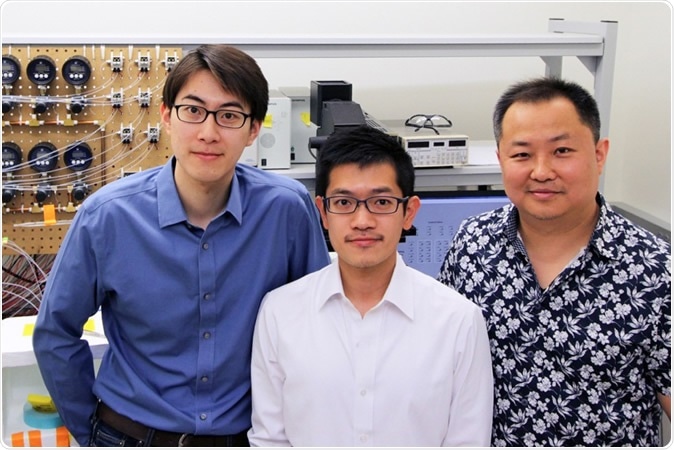Humans differ from one another in many ways, including how they react to disease, because of their DNA blueprint, as well as the difference in the environments they face. These factors combine to make each person unique. Now a new study published in the journal Nature Protocols reports the development of a promising technology to uncover the process by which the body fights diseases in different ways.

A Virginia Tech professor and his team of researchers have created new technology to help in understanding how the human body battles diseases. Left to right, Bohan Zhu, Yuan-Pang Hsieh, and Chang Lu.
The study is based on the use of microfluidics technology to explore the body’s response in terms of epigenomic changes to a variety of disease conditions, whether psychiatric like schizophrenia or substance abuse, or physical such as breast cancer.
The reason for embarking on this study was the lack of knowledge about what actually determines the nature and working of the disease process even after decades of investigation into these conditions, which the researchers say is because there were no sophisticated and accurate technologies to probe them. Hence, they made up their own approach to the problem.
Their solution consists of microfluidic oscillatory washing to produce immunoprecipitation of chromatin, the substance of which DNA is made, followed by a low-input sequencing technology called MOWChip-seq. They have provided full instructions on how to produce, set up and operate the device. The result is a detailed description of the epigenome even when only a hundred cells are available.
Epigenomic changes
The epigenome is a full picture of the chemical alterations that have occurred in DNA and histones (DNA-binding proteins) in an organism, and which can be passed down to the offspring. The DNA sequence itself is unchanged, but the chemical groups attached to the DNA and histone backbone are altered, for example by the attachment of methyl groups, called DNA methylation. For instance, an animal exposed to stress chronically has a higher than usual level of stress hormones, which modifies the level of methylation of certain DNA regions within the brain cells. Such epigenetic changes result in an altered pattern of gene expression.
Microfluidics
The science of microfluidics consists of handling and controlling very small amounts of fluids, measured in picoliters to microliters, using tiny networks of fine channels that are themselves only a few microns to a few hundred microns in diameter. Originally proposed in the 1990s, it has found a tremendous range of applications in a wide spectrum of fields, from biology to information technology.
The advantages of microfluidics include, obviously, a striking reduction in costs, since only very minute amounts of samples and reagents are required. This is especially observed with the use of expensive reagents. Moreover, it offers extremely high sensitivity in detecting and resolving molecules of different types.
It takes up very little space compared to conventional laboratory assay machinery for analysis and diagnosis of biological systems. Flow control is superior, analysis times shorter, and results are obtained faster.
Immunoprecipitation
Chromatin immunoprecipitation (ChIP) refers to the technique of isolating chromatin from a solution containing many different proteins by using a specific antibody to bind it, followed by the precipitation of the antigen-antibody complex. In this process, DNA is linked via formaldehyde-induced crosslinks to DNA binding proteins. The chromatin bound to the proteins is now isolated and cut into small fragments. The antibodies to the DNA-binding protein are added to bind the complex specifically and this causes it to precipitate out of solution. Now the crosslinks are reversed, and the proteins are digested. PCR is used to amplify certain sequences of the DNA so that their presence in the precipitate can be verified.
MOWChIP
MOWChIP is a specialized ChIP-sequencing process that is intended to enable low-input multiplexed sequencing of DNA. The primary difference from conventional ChIP-seq assays is the use of microfluidic chambers for the ChIP and washing steps.
The MOWChip-seq is also Lu’s brainchild, and its development has been described in 2015 in the journal Nature Methods. Lu and his collaborator, doctoral candidate Zhenning Cao, received a US patent for this project. Moving forward, Lu’s current team has now automated the process and converted it into a tool capable of sequencing 8 samples per run. The automation helps reduce the labor-intensive nature of the work, makes the results more reproducible, and allows the process to be scaled up or down as required.
Benefits
So, what’s new? For one thing, previously used methods needed to use several tens of millions of cells to conduct an assay, compared to 100 cells with this sequencing method. This has enabled the researchers to produce a profile of histone modifications with very scanty material. Secondly, the output is high, with up to 8 assays being done per run.
Implications
The important thing, says researcher Chang Lu, is that “by comparing normal and diseased epigenomes, useful markers and patterns can be discovered and used for precision medicine based on epigenomic features of an individual patient.”
Journal reference:
Zhu, B., Hsieh, Y., Murphy, T.W. et al. MOWChIP-seq for low-input and multiplexed profiling of genome-wide histone modifications. Nat Protoc 14, 3366–3394 (2019) doi:10.1038/s41596-019-0223-x, https://www.nature.com/articles/s41596-019-0223-x